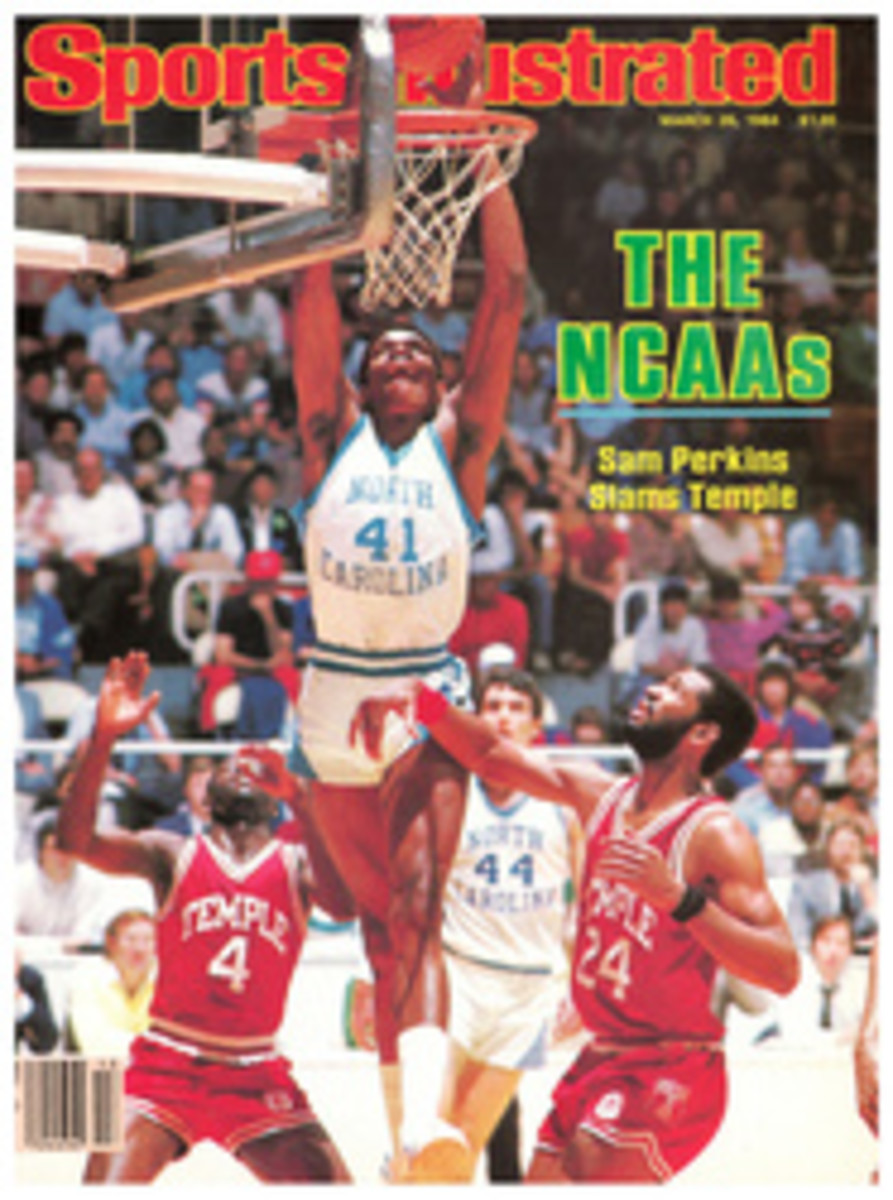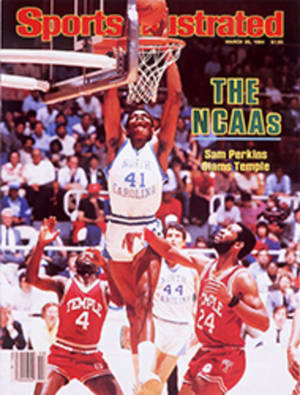
KNEE BRACES ARE THE BEST FRIENDS THAT A BAD—OR GOOD—KNEE EVER HAD
When Notre Dameoffensive tackle Mike Shiner went down with a knee injury during a 1982preseason football practice, nobody thought it possible that he would return tothe Irish in only four weeks, sound and ready to play. His quick return iscredited, in part, to a brace he was wearing at the time of the injury, calledthe McDavid Knee Guard. The McDavid is one of the two knee braces most widelyused in athletics today. The other is the Anderson Knee Stabler, which issimilar in design and favored by many NFL teams.
"The youngman would have been finished playing football," says coach Gerry Faust,"but the knee brace saved him. He had an injury, but he would havedestroyed the knee if he hadn't had the knee brace on." Irish athletictrainer John Whitmer agrees. "Without the brace, Shiner's injury would havebeen much more traumatic," he says. "We did arthroscopic surgery [atechnique used to "see" inside the knee] on him and found partial tearsin his ligaments. We attribute his lesser injury to the brace."
The brace wasdeveloped in the late 1960s by Dr. Robert McDavid, a former college footballcoach at New Mexico Military Institute who is now professor of exercisephysiology at Indiana State. His invention is gaining wide acceptance among thenation's college athletic trainers and football coaches. Notre Dame, Oregon,Tulane, Louisiana State, Tennessee and West Virginia are among the many teamsusing the brace to help prevent knee injuries.
At Notre Dame thebrace is mandatory in practice for offensive and defensive linemen, linebackersand tight ends. Faust requires the linemen to wear it during games.
At Oregon, muchthe same applies. "We use it on various people at different positions,"head trainer Dean Adams says. "It's mandatory on contact days in practiceand one-third of our people voluntarily use it in the games.
"We've cutdown on knee injuries. There have been some slight strains on ligaments, and aplayer may be out from a day to a couple of weeks, but we've had only onesignificant injury. Some players say that when they're hit from the outside andfeel the knee start to go, the brace takes over and the leg straightens out.They became believers. The brace held the knee intact."
That, of course,is the basic purpose of the brace. "We want to prevent injury to a healthyknee and help avoid reinjury to a damaged knee," McDavid says. "So far,we've been highly successful."
According toMcDavid, damage to the knee accounts for 21% of all sports injuries. The reasonis simple: The knee isn't designed to move from side to side. There are fourmajor ligaments in the knee—two on the outside and two on the inside of thejoint. All are susceptible to damage, but most knee injuries involve the medialcollateral, an outside ligament, and the anterior cruciate, an inside ligament.(The lateral collateral is the other outside ligament; the other insideligament is the posterior cruciate.) The medial and lateral collaterals,located vertically along each side of the knee, prevent it from moving fromside to side. They serve as braces for the knee. An athlete hit hard from theoutside may suffer damage to the medial collateral. When this happens, the kneebecomes unstable. Ligaments, made up of many fibers, can be partially orcompletely torn. Reconstructive surgery is sometimes necessary and often notcompletely successful.
The sleeve-typeMcDavid Brace is pulled over or wrapped around the knee and is secured bydouble Velcro strips both above and below the knee. Tape can also be applied toadd more support. A splint made of Lexan, a virtually indestructiblepolycarbonate, is sewn inside. The splint is hinged at the knee joint and runsalong the outside of the leg, forming a bridge between the upper and lower leg.In a sense, the brace acts as a second medial collateral ligament.
"We've soldmore than 13,000 units so far," McDavid says "and only a half dozen orso have been returned to us. And the only injuries of any consequence have beento the player at Notre Dame and one at Oregon. We're confident that itworks." Many teams using the brace are keeping records on itseffectiveness, although a true scientific study hasn't yet been made. As NotreDame's Whitmer points out, "It's too early to tell. We've been using it forthree years, but it could take five to eight years to get the statistical datawe need."
McDavid begandeveloping his brace in 1967. "I was a little skeptical myself, especiallyafter people tell you for years and years that you can't get anything that'sgoing to work on the knee," he says. "But I put my brace on a player atthe University of Southern Mississippi, where I was teaching, who had the worstknee I'd seen up to that time. He had medial and lateral damage that wouldn'tlet him do anything strenuous.
"So I put thebrace on him, and he felt absolutely good and wanted to play ball right thenand there. He was so enthused he got his cleats and put them on to see if hecould make some cuts. I said, 'Be careful, be careful,' because I didn't wanthis knees to rip out. But he ran zigzag patterns quite easily. I was prettyconvinced then my idea was working."
By 1970 McDavidhad a patent for the brace, though few shared his confidence in itseffectiveness. "At first, I sent out flyers to all the trainers and coachesin the professional leagues," he says, "and also sent them a prototypeof the brace and asked for some feedback. I never heard a word from anybody,but I wasn't discouraged."
Instead, he triedto interest a sporting goods company, and again struck out. "I found theydidn't understand the structure," McDavid says. "Other companies hadchances to market it, too, but refused. So I got my own mold and began to makethem myself. I made them in my basement until about three years ago and I sentout about 300 per year in the early years. But now, with our success, my son,Robert McDavid III, is manufacturing them at a plant in Conway, Arkansas. Anddemand is increasing so rapidly he has a full-time job on his hands."
The other brace,the Anderson Stabler, was designed by L.A. Raider trainer George Anderson andnamed after quarterback Ken Stabler. It's manufactured and distributed by OmniScientific Inc. of Lafayette, Calif. Omni spokesman Jim Mercer contends thatthe Anderson, first marketed in 1981, is more effective than the McDavid."We've improved upon it," he says. "It has a hinge that pivots atthe knee joint, which allows greater flexibility. Also, it has asteel-reinforced bridge over the knee that can take greater stress thanplastic. Our brace is preferred at the University of Southern California, UCLAand all the other Pac-10 schools. And studies are being conducted. For example,North Carolina purchased 75 of our braces and 75 of McDavid's design. They usedthem both for one year and chose ours."
Severalknee-brace designs became available in the 1960s. Some were marketed by largesporting-goods companies, including MacGregor, Wilson and Bike. Most of thebraces utilized thin metal or plastic straps sewn into elastic, which didn'tgive much support. The elastic would slip from the knee and couldn't supportthe knee against medial or lateral extension. The elastic expanded with forceand allowed the knee joint to separate, making the braces ineffective.
Until thedevelopment of the McDavid and Anderson, the Lenox Hill was the brace most usedin sports. Invented by Dr. James A. Nicholas, the New York orthopedic surgeonwho treated Joe Namath's famous knees, it was designed to support and protectunstable knees. But a report in the September-October, 1983 issue of TheAmerican Journal of Sports Medicine says the Lenox Hill brace may not be aseffective as first thought.
Other braces areavailable, including ones produced by companies such as Zinco and Can-Am. Theseand the Lenox Hill are usually considered postoperative or post-injury braces.Proponents of the McDavid and Anderson braces stress their value in injuryprevention.
"You'reinvesting $40,000 in education for a young man on scholarship," Faust says,"and if he can't play, the $40,000 is down the drain. If you pay $30 to $40for a brace, it's worth the investment." The cost of medical care for aninjured player is also substantial. "You have the surgeon's bill, thehospital bill and the anesthesiologist's bill," Whitmer points out."Fortunately, we don't have to pay for rehabilitation because we do ithere."
The McDavid KneeGuard costs about $40, the Anderson Knee Stabler $29 to $50. Both can also beused in other sports, such as hockey and skiing. Knee braces also are beingused by construction workers who have to climb up and down scaffolds all day.Football players would seem to need them most, though.
"Oneday," McDavid says, "our brace, or perhaps one like it, will be arequired piece of equipment, just like shoulder pads, helmets, face masks andsuch. It's only a matter of time."

